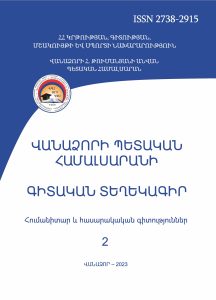Structural-Semantic Types of Modern Armenian and English Two-Component Verbal Phraseological Units
Scientific Proceedings of Vanadzor State University Humanitarian and Social Sciences (ISSN 2738-2915)
2023 vol 2
Structural-semantic types of modern Armenian and English two-component verbal phraseological units
Sona Simonyan
Summary

Keywords and phrases։verb of analytical structure, verb-particle construction, phrasal verb,non-verbal component, meaning, comparison.
Both Armenian and English are rich in these units. Verbs of analytical structure in both languages can be divided into two groups: analytical verbs that don’t have phraseological meaning and those that possess it.
The study of verbal phraseologicalunits provides an opportunity to better understand the similarities and differences between languages, cultures and character of peoples.
In this article, we have conducted a thorough examination and categorization of substantial groups of Armenian and English two-component verbal PUs based on the semantic attributes of their non-verbal components. Our analysis has employed both comparative and analytical methods.
Based on the interpretations of the non-verbal component, two-component verbal phraseological units (PUs) can be categorized into several discernible groups. These groups encompass PUs in which the non-verbal component pertains to the human body or body parts, the psychological and intellectual facets of human cognition, as well as physical capabilities, distinct characteristics, emotional expressions, interpretations of various natural occurrences, various natural phenomena, the animal world, food, place and direction.
A substantial proportion of two-component verbal PUs has equivalence in the languages under consideration. Such correspondences often emanate from shared cognitive patterns across different cultures, analogous worldviews, and common interpretations of diverse phenomena. In certain instances, these PUs may also manifest as linguistic loans.
However, it is noteworthy that numerous two-component verbal PUs are inherently language-specific, lacking direct counterparts in the language under consideration.
https://doi.org/10.58726/27382915-2023.2-21
